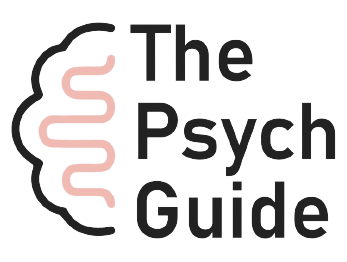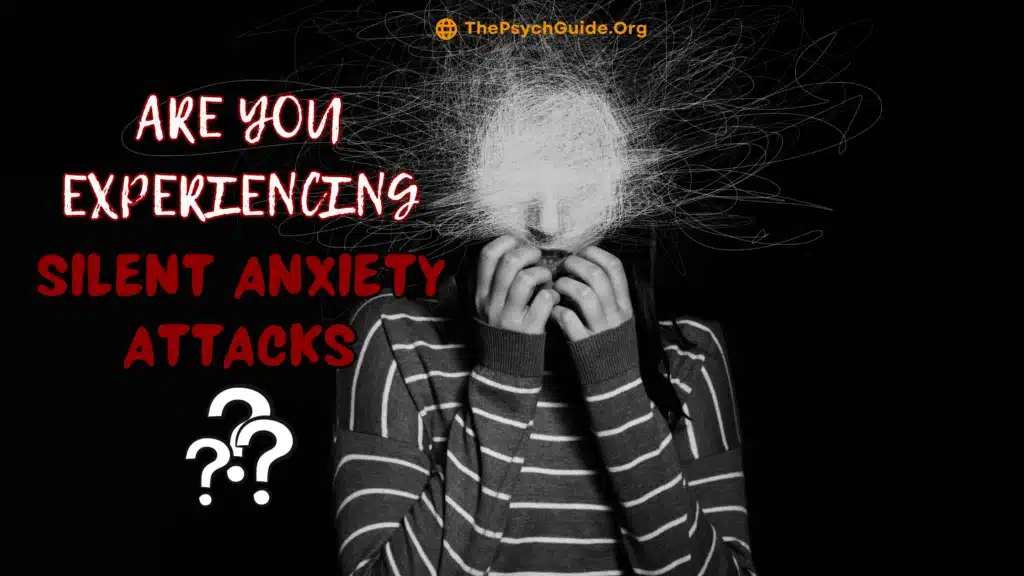Have you experienced moments where your heart races, your palms sweat, and your mind spins with worry, all while wearing a smile on the outside? If so, then you might have experienced a ‘Silent Anxiety Attack’. It goes unnoticed by those around you but causes silent internal chaos.
Perhaps you have heard of panic attacks but what is Silent Anxiety Attack? We usually associate anxiety and other mental health problems with visible symptoms such as crying and shaking but silent anxiety attacks have less noticeable and visible symptoms.
Let’s dig deeper into the topic of silent anxiety attacks and their symptoms, impacts, and how they are different from normal anxiety. We are also going to study its triggers, causes, and how to cope with them. And yeah, don’t miss our recommendations on Amazing Self-Help Books that can help you effectively overcome silent anxiety.
Table of Contents
ToggleWhat Is a Silent Anxiety Attack?
A silent anxiety attack is characterized by intense internal turmoil such as racing thoughts, tightness in the chest, an increased heart rate, and an overwhelming fear of loss of control. It goes unnoticed by others around you. It’s like a storm raging beneath the surface while the world around you sees calm waters. These attacks are akin to silent anxiety attacks hidden by smiles, concealing the inner turmoil behind a calm exterior.
Prevalence of Silent Anxiety Attack
The prevalence of silent anxiety attacks is difficult to measure as these attacks often go unnoticed or unreported but let’s look at some studies that show their prevalence.
A study published in the Journal of Affective Disorders found that 4.7% of a community sample reported experiencing recurrent silent panic attacks (a severe form of silent anxiety).
Another study published in the Journal of Clinical Psychiatry suggests that up to 30% of individuals with panic disorder might primarily experience covert panic attacks, emphasizing the potential underdiagnosis of silent anxiety.
Signs and Symptoms of Silent Anxiety Attacks
Silent Anxiety Attacks are challenging to diagnose but there are some common symptoms of a silent anxiety attack that can help identify them. Let’s study and take our knowledge of silent anxiety attack signs and symptoms.

Mental and Emotional Symptoms
- Dread and Fear :Silent anxiety attacks feel like an intense feeling of doom. It’s like a dark cloud hanging over your head, casting a negative shadow on everything.
- Racing and Intrusive Thoughts: A constant stream of worries, and “what if” scenarios bombards your mind when you have a silent anxiety attack. These thoughts can be intrusive and feel impossible to control, making it difficult to focus or relax.
- Depersonalization and Derealization: Depersonalization can be described as when you feel detached from your body, while derealization is when you feel disconnected from your surroundings. A silent anxiety attack makes you feel disconnected from yourself or your surroundings. If your reality seems distorted or dreamlike, causing a sense of detachment and unreality and making you feel a little bit out of your body, then you may be experiencing a silent anxiety attack.
- Fear of Losing Control: Signs of a silent anxiety attack include fear of losing control. You fear that you’re about to lose control of your emotions, body, or situation. This can lead to a desperate desire to escape or find immediate relief.
- Difficulty Concentrating and Mental Confusion: The overwhelming internal storm can make it difficult to think clearly, follow conversations, or complete tasks. Your mind feels foggy and is unable to focus.
- Heightened Irritability and Frustration: The internal struggle due to a silent anxiety attack can manifest as a short temper, impatience, and frustration with yourself or others.
- Feelings of Isolation and Loneliness: Silent anxiety attack symptoms include feelings of loneliness and isolation. You will feel isolated and misunderstood even in a crowd. The invisible nature of the attack can make it difficult to seek help or connect with others who understand.
Physical Symptoms
- Tightness in the Chest or Stomach: You may feel tightness in the chest or stomach as silent anxiety attacks overtake you. Even though there’s going to be no physical pain, you will experience a sense of tightening or pressure in your chest or abdomen.
- Nausea or Dizziness: Nausea or dizziness is also a physical symptom of a silent anxiety attack. You may feel an unsettled feeling in your stomach, accompanied by lightheadedness or a sense of spinning. A person going through a silent anxiety attack may start to get aches in their stomach and may experience other gastrointestinal upsets.
- Muscle Tension and Tremors: Silent anxiety attack symptoms include involuntary tightening of muscles, often in the shoulders, neck, or jaw, leading to subtle tremors. Many people feel weaker in their arms, legs, hands, and feet. This is due to the decrease in blood flow, which makes your hands and feet tingle and numb as if you are staying in one position for too long.
- Fatigue and Lethargy: Lethargy and feeling tired are also symptoms of a silent anxiety attack. There are feelings of physical and mental exhaustion and drained energy levels, even after minimal activity.
- Headache: Silent anxiety attacks can also cause headaches. The anxiety and tension that build up during the attack may cause your head to pound.
- Shallow Breathing: Your breathing becomes shallow as you go through a silent anxiety attack because you become aware of your breaths. This is due to your brain not getting enough oxygen so it intensifies the sensations caused by anxiety and panic.
- Hypervigilance: Hypervigilance is when you become extremely aware of the physical and internal body sensations around you. This increased sense of awareness can worsen the distress and initiate a cycle of anxiety that can be difficult to let go of.
- Constricting Throat: Your throat feels like it’s closing up as you go through a silent anxiety attack. Many people feel that their throats are constricting, while others may feel a lump in their throat that makes them unable to talk.
- Increased Heart Rate: If you begin to have heart palpitations, like skipping a beat, and your heart rate becomes faster than normal, then you might be going through a silent anxiety attack. It’s also one of the physical symptoms of an anxiety attack, which makes it easier to identify it.
- Changes in Appetite: Silent anxiety attacks also impact your appetite, as you may feel a loss of appetite or sudden cravings for unhealthy foods.
- Sleep Disturbances: Silent anxiety attacks also manifest in disrupted sleep patterns. Difficulty falling asleep, staying asleep, or experiencing nightmares are the common signs of silent anxiety attacks.
It’s important to remember that the symptoms of silent anxiety attacks can vary greatly in intensity and duration. Some may last for minutes, while others can linger for hours or even days. The key takeaway is that even without the outward signs, these attacks are real and can significantly impact your well-being.
Impact of a Silent Anxiety Attack on an Individual
Despite lacking visible cues and symptoms, the internal experience during a silent anxiety attack can be intense with great impact on an individual’s mental, emotional, and physical well-being.
- Silent anxiety attacks can make a person socially isolated and avoid gatherings due to the fear of others noticing or misunderstanding their internal struggle. It can lead to the avoidance of situations that might trigger an attack. Additionally, shame and stigma surrounding mental health can further isolate individuals experiencing silent attacks, hindering their seeking help.
- Silent anxiety attacks can lead to impaired cognitive function. Difficulty concentrating, making decisions, and processing information can impact work performance, academic success, and everyday tasks.
- They reduced engagement in the activities of an individual. Enjoyable activities and hobbies might lose their appeal and become less interesting for the individual due to the constant vigilance and worry associated with potential attacks.
Remember, if you doubt or suspect that you or someone you know might be experiencing silent anxiety attacks, seeking professional help from a therapist or counselor is crucial.
Triggers and Causes of Silent Anxiety Attacks
Silent anxiety attacks, despite their invisible symptoms, are still very real and can be just as distressing. Several factors can cause silent anxiety attacks.
Causes Of Silent Anxiety Attack
Anxiety Disorders
People with generalized anxiety disorder, social anxiety disorder, or panic disorder are more prone to silent anxiety attacks. These disorders can involve chronic worry, excessive fear of social situations, or recurring episodes of intense fear, respectively.
Silent anxiety attacks can often co-occur with depression due to feelings of hopelessness and worthlessness fueling internal anxiety.
Other mental health Conditions
Trauma, PTSD, and OCD can also increase the risk of silent anxiety attacks due to emotional distress and intrusive thoughts that occur during these conditions.
Triggers
Stressful Life Events
Many stressful life events, such as financial problems, relationship issues, or work stress, can trigger and contribute to silent anxiety attacks, especially in individuals with underlying vulnerabilities.
Uncertain Situations
Unpredictable situations that are out of control can intensify internal anxiety, leading to silent attacks.
Personality Traits
Individuals with perfectionism, neuroticism, or high sensitivity to negative emotions may be more susceptible to silent anxiety attacks as they tend to overthink worries and fears.
Physical Health Problems
Chronic pain, illness, or substance abuse can put additional strain on the body and mind and can also cause silent anxiety.
It’s important to remember that everyone experiences anxiety differently. What triggers one person may not trigger another but having knowledge about their causes and triggers is a must to develop coping mechanisms.
How to cope with Silent Anxiety Attacks
If you are wondering, how do you calm silent anxiety? Then there are some treatment options and lifestyle changes that you can adopt to overcome your hidden anxiety attacks

Treatment Options
Psychotherapy
Cognitive-behavioral therapy (CBT) is particularly effective for identifying and challenging negative thought patterns that contribute to anxiety. Other approaches, like mindfulness-based therapy and acceptance and commitment therapy (ACT) can also be helpful.
Medication
In some cases, medication like antidepressants or anti-anxiety medications might be recommended by a doctor, especially if your anxiety is severe and interferes with daily life.
Support groups
Connecting with others who understand your struggles can provide invaluable support and validation.
Coping Strategies and Therapeutic Techniques
Identify and avoid triggers
You should identify your triggers and ask yourself What events or situations bring panic attacks? Paying attention to situations or events that seem to trigger your anxiety can help you develop strategies for avoiding them and find ways to manage them.
Grounding techniques
Practicing slow, deep breathing or engaging in simple physical movements like tapping your feet and focusing on your senses (5-4-3-2-1 technique) can help anchor you in the present moment and interrupt racing thoughts.
Mindfulness and meditation
Regular practice can help increase self-awareness, manage stress, and reduce overall anxiety levels.
Relaxation techniques
Many relaxation techniques can help reduce anxiety, such as progressive muscle relaxation, yoga, and deep breathing, and others can help manage muscle tension and bodily symptoms associated with anxiety. Find out what works best for you.
Journaling
Recognizing and expressing your thoughts and feelings through writing can be cathartic and provide valuable insights into your triggers and coping mechanisms.
Lifestyle Changes
Prioritize self-care
Schedule time for activities you enjoy, practice relaxation techniques and prioritize sleep and healthy eating to support your mental and physical well-being.
Set realistic goals
Don’t overload yourself. Break down large tasks into smaller, manageable steps and celebrate your achievements along the way.
Healthy habits
Exercising regularly, eating a healthier and more balanced diet, getting adequate sleep, and limiting caffeine and alcohol intake can all contribute to better emotional well-being and resilience against anxiety.
Seek support
Don’t hesitate to reach out to trusted friends, family, or a therapist for help and support. Remember, you’re not alone in this journey.
Coping with silent anxiety takes time and effort. Be patient with yourself, celebrate your progress, and don’t be afraid to seek professional help if needed. You deserve to live a life free from the grip of anxiety.
Therapy-providing organizations
Silent anxiety attacks can be difficult to manage, but many organizations can help. Here are a few resources:
The April Center for Anxiety Attack Management
It provides therapy and support for people with anxiety disorders. They have a team of experienced therapists who can help you develop coping mechanisms and manage your symptoms.
The National Alliance on Mental Illness (NAMI)
It is a grassroots organization that provides support and education for people with mental illness and their families. They have a helpline that you can call or text 24/7 for support.
The Anxiety and Depression Association of America (ADAA)
It is a national organization that provides information and resources on anxiety and depression. They have a website and a helpline that you can call or text for support.

Transform Your Life with These Reads
If you love reading books, then there are many self-help books available that can help with silent anxiety attacks.
1. Attacking Anxiety: From Panicked and Depressed to Alive and Free
This is a book by Shawn Johnson. In his book, he shares vulnerably about his dark time and offers those familiar with that same struggle everything he’s learned in his battles with anxiety, depression, and hopelessness.
2. Silent Suicide: Manage Your Anxiety and Maximize Your Life
This book is by Chandra Smallwood. In this book, readers will gain a foundation to better manage and holistically prevent anxiety while also setting a path to a happier, healthier, and more fulfilling lifestyle.
3. Becoming Calm: Silver Lining Anxiety Workbook and Journal
Ann Silvers MA, the author of this book, is a therapist who understands what anxiety feels like because she has dealt with it herself. Through her personal experience, training, and decades of helping clients overcome everything from generalized anxiety (GAD) to phobias to PTSD, Ann Silvers, has unique insight into what anxiety is and what helps relieve it.
Common Misconceptions
A Silent anxiety attack can be incredibly misunderstood because it lacks the outward signs of traditional panic attacks and they are also harder to identify and diagnose. There are many misconceptions attached to it. Here are a few of them.
- It is a misconception that they are not real anxiety attacks as they don’t involve physical symptoms like shortness of breath and crying. They are very real as the person experiencing them only knows what destruction is happening inside them.
- People who experience silent anxiety attacks are often told that they’re making a big deal out of nothing. This can be incredibly invalidating and make it even harder to cope with the attack.
- Many people also think that there’s nothing you can do about silent anxiety attacks. This is simply not true. There are several effective treatments for anxiety, including therapy, medication, and lifestyle changes.
- They are also misinterpreted as a sign of weakness. The isolation and shame associated with silent attacks can lead individuals to believe they’re weak or incapable of coping. However, anxiety is a common and treatable condition, and experiencing silent attacks is not a reflection of personal weakness.
- People who go through silent anxiety attacks are being told that they are just attention-seeking. This is a cruel and unfair accusation. People who experience silent anxiety attacks are not trying to get attention. They are simply trying to cope with a very real and distressing experience.
Openly discussing mental health is crucial for breaking down stigma, fostering understanding, and ensuring everyone has access to the support they need.
We should engage in open conversations about mental health by being open about our mental health journey and speaking up when hearing harmful stereotypes or misinformation about mental health. When someone opens up about their mental health, we should listen to them without judgment and offer support.
Conclusion
Silent anxiety attacks are often misunderstood due to their invisible nature but they are real and can impact anyone at any time. The person having a silent anxiety attack experiences internal turmoil and overwhelming fear.
Mental health struggles can’t always be seen on the surface so we need to practice empathy and understanding. By breaking the silence surrounding silent anxiety attacks and engaging in open conversations, we can create a more supportive space for the people going through them.
Let’s educate ourselves, reach out to others to help them, and embrace the power of dialogue and communication to break the stigma and provide a safe environment for those silently battling with anxiety.
FAQs
What does a silent anxiety attack feel like?
During a silent anxiety attack, one may experience racing thoughts, a feeling of impending doom or dread, a tightness in the chest, and an overwhelming sense of unease. There may be an urge to escape the situation or a heightened feeling of restlessness. Physical symptoms like increased heart rate, trembling, or sweating may also occur but are not as outwardly visible.
How do you stop a silent anxiety attack?
Stopping a silent anxiety attack can be challenging, but there are techniques that can help manage the symptoms and provide relief.
- Firstly, it’s important to acknowledge and recognize what is happening. Take deep breaths and try to focus on your breathing, as it can help to slow down your heart rate and provide a sense of calm.
- Grounding techniques can also be effective, such as engaging your senses by noticing and describing things around you or using tactile objects to redirect your focus.
- It can be helpful to challenge negative or irrational thoughts by questioning their validity and providing yourself with evidence to the contrary.
- Additionally, practicing self-care activities like taking a short walk, engaging in activities that bring you joy, or listening to calming music can help distract your mind and reduce anxiety symptoms.
Am I having an anxiety attack?
Anxiety attacks, also known as panic attacks, can vary from person to person. Symptoms often include a rapid heart rate, shortness of breath, sweating, trembling, chest discomfort, dizziness, or a feeling of impending doom. If you are having these symptoms then it could be an anxiety attack. It is essential to consult with a healthcare professional to receive a proper diagnosis and guidance.
What does a panic attack feel like?
An acute episode of severe fear or discomfort that peaks in a matter of minutes is known as a panic attack. Some of the symptoms commonly experienced during a panic attack include a rapid heartbeat, pain in the chest, difficulty breathing, dizziness, or shaking, a feeling of choking, nausea or stomach discomfort, chills or hot flashes, sweating, numbness or tingling sensations, a sense of impending doom, and fear of losing control or dying.
How long do silent panic attacks last?
The duration of silent panic attacks can vary for each individual. Some individuals may experience brief episodes that last for a few minutes, while others may have longer-lasting episodes that can persist for hours.

